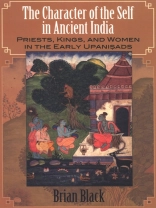This groundbreaking book is an elegant exploration of the Upanisads, often considered the fountainhead of the rich, varied philosophical tradition in India. The Upaniṣads, in addition to their philosophical content, have a number of sections that contain narratives and dialogues—a literary dimension largely ignored by the Indian philosophical tradition, as well as by modern scholars. Brian Black draws attention to these literary elements and demonstrates that they are fundamental to understanding the philosophical claims of the text.
Focusing on the Upanisadic notion of the self (ātman), the book is organized into four main sections that feature a lesson taught by a brahmin teacher to a brahmin student, debates between brahmins, discussions between brahmins and kings, and conversations between brahmins and women. These dialogical situations feature dramatic elements that bring attention to both the participants and the social contexts of Upanisadic philosophy, characterizing philosophy as something achieved through discussion and debate. In addition to making a number of innovative arguments, the author also guides the reader through these profound and engaging texts, offering ways of reading the Upaniṣads that make them more understandable and accessible.
Table des matières
Acknowledgments
Abbreviations
Introduction
Opening statement
What are the Upanisads?
The self, life, death, and immortality
The historical and social context
Characterizing the self
Literary characters
The social conditions of knowledge
Mystery or mystique: The character of knowledge
1. Teachers and students: The emergence of teaching as an object of discourse
Introduction
Sandilya and the teaching of
atman and
brahman
Sandilya: From ritualist to teacher
Uddalaka Aruni and the teaching of
tat tvam asi
Uddalaka and Svetaketu: Acting out the
upanayana
Indra as the persistent student
Narada and Sanatkumara: Knowledge of
atman as more important than the Vedas
Naciketas and the initiation of an Upanishadic brahmin
The graduation of a brahmin student in the
Taittiriya Upanisad
Satyakama and the beginnings of a brahmin hagiography
Conclusion
2. Debates between brahmins: The competitive dynamics of the
brahmodya
Introduction
The
brahmodya and the sacrifice
Uddalaka Aruni and the
brahmodya in the
Satapatha Brahmana
Yajnavalkya and the philosophical tournament
Yajnavalkya’s interlocutors: The social and political implications of debate
Yajnavalkya and the tactics of debate
Losing face or losing one’s head? The motif of head shattering
Upanishadic teachings and material wealth
Yajnavalkya and renunciation
The life story of Yajnavalkya
Conclusion
3. Kings and brahmins: The political dimensions of the Upanisads
Introduction
The myth of
ksatriya authorship
Janaka and Yajnavalkya: Negotiating the brahmin’s position in the court
Janaka and Yajnavalkya in the
Brhadaranyaka Upanisad
Kings as teachers: Asvapati teaches a group of brahmin householders
Uddalaka Aruni and Svetaketu: Instructions for how to seek patronage
Conflicting agendas for how kings should teach brahmins
Upanishadic knowledge as a political discourse
The battle of the
pranas as a political metaphor
Pravahana and the teaching of the five fires
Conclusion
4. Brahmins and women: Subjectivity and gender construction in the Upanisads
Introduction
The gender of the self:
Atman and the male body
The self, virility, and immortality
Yajnavalkya and Satyakama: Competing ideals of male subjectivity
The myth of recovering an authentic female voice
Gargi: The debating tactics of a female philosopher
Women and
gandharvas: The lack of authority for female speakers
The ambiguities of Satyakama’s mother and wife
Maitreyi and Katyayani: Knowledge of
atman versus
striprajna
Conclusion
Conclusion
Notes
Glossary
Bibliography
Index
A propos de l’auteur
Brian Black is Research Associate at the School of Oriental and African Studies at the University of London.







![Couverture du Brian Schrag & Julisa Rowe: Community Arts for God's Purposes [Chinese] 貼近神心意的社群藝術 Couverture du Brian Schrag & Julisa Rowe: Community Arts for God's Purposes [Chinese] 貼近神心意的社群藝術](https://static.worldofdigitals.com/thumb_webp/740/9781645083740.webp)




